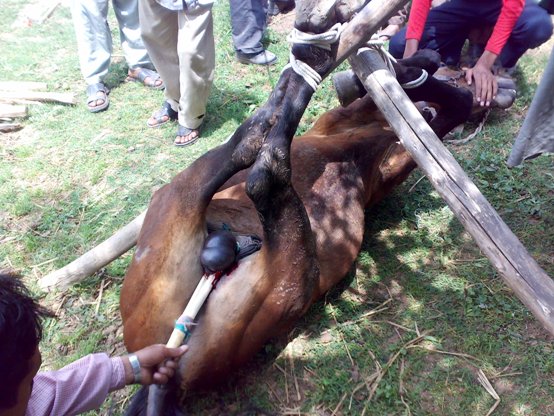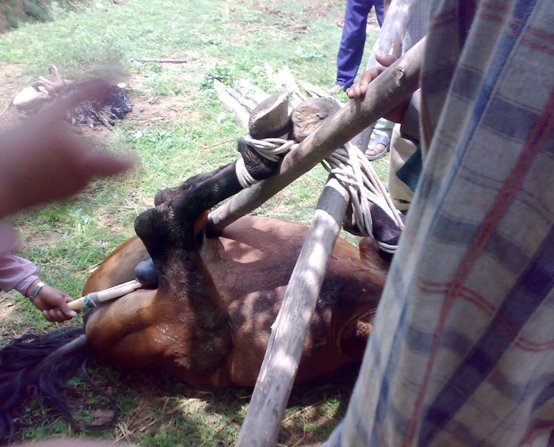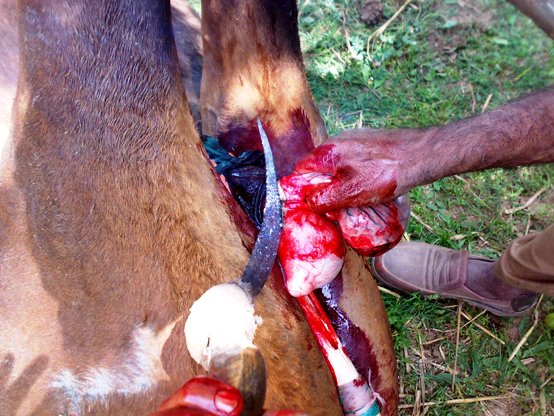Animal Cruelty at its Worst
Posted by Anjum Andrabi on September 29th, 2008
See how a horse is castrated (testicles removed) in these pictures. The persons who perform this savage operation are usually locals with no medical training. Their chief tools are razor blades and an iron sickle. The legs of the horse are tied to wooden poles which are held above its trunk. Another person holds the horses head pinned to the ground. The skin of the scrotum is cut open using the razor and then the sickle, which is heated red, is used to simply burn through the testicular attachments and cord. Needless to mention that no anesthetic is used at any stage during the process. This practice is prevalent especially among the tribal communities living in the highlands of the Kashmir valley.
Questions that may come to ones mind:
1. Why is it done?: No, this is not done for any sadist pleasure, there is some scientific evidence that castration of animals causes them to turn docile and easy to handle.
2. Why use an untrained person? Is it cheaper?: Not at all, in fact the practitioners demand good money, a single operation may fetch them a 1000 rupees ($25) and above. While if this is done at a state sponsored veterinary center, it would be free for the owner.
3. Why do horse owners prefer these quacks to the qualified veterinarians?: For a simple reason, no Vet would perform this surgery without proper equipment and drugs, both of which are missing from the rural centers. Some vets carry their own surgical sets but charge much more than our “cruel doctor”, so his popularity remains.
4. How bad is it for the horses?: Apart from the evidently excruciating pain, the horses get infections, abscesses and some even die of peritonitis and shock since no post operative antibiotic is used. Also horses are especially sensitive to tetanus and as one can see from these snaps, asepsis is the least concern. Moreover, when a bleeding cord retracts into the abdomen it can lead to many complications later on like adhesions and strangulation.
















September 30th, 2008 at 3:36 am
No doubt cruel! Any thoughts as to why they have to practice this. Do they have sufficient veterinary coverage. Are veterinary services at their disposal. I hope this is not happening even when they have a veterinary coverage. What they need most is some professional help..more then anything else-in this regard.
September 30th, 2008 at 10:25 am
Dear Dr. Andrabi,
I think you should train horse owners that they must reffer the horses to a Vet clinic or to a facilities centers to castration. In Iran these procedures were performed free of charge in educational centers such as Vet schools or hospitals. Any way I feel very turmoil and panic when I saw these barbaric method!
Sincerely yours,
Dr. Amin Bigham Sadegh DVM, PhD in veterinary surgery
Department of Veterinary Surgery and Radiology,
School of Veterinary Medicine,
Shahrekord University, P. O Box: 115, Shahrekord, Iran
Fax:00983814424427
Tel:00983814424427
http://www.sku.ac.ir
October 2nd, 2008 at 8:33 pm
It is pathetic.No concept of pain management.I wonder how the person who is doing the procedure will feel if the same thing is done to him in the same operating conditions.Yes! we do have to go a long way if we want such practices to be a history.
October 2nd, 2008 at 11:53 pm
This looks worse than it is in reality. The scrotum is being held tight by some kind of mechanism that disables the blood circulation and therefore makes it almost painless. I know most of you will think I’m crazy for saying this, but I know what I’m saying. Of course in these images the methods are way too primitive which makes it it hard for anyone to look at it.
I therefore want to make it clear that I don’t endorse the practice of this primitive method of castration. It should be done by Vets with the most advanced surgical tools available.
But again I say this pics make it look a lot worse than it really is. The clinical method for castration is quite similar and doesn’t involve any anesthetics as it is said in the text.
And we have to understand that this was done in a third world country…
Sorry about my poor English.
October 11th, 2008 at 10:52 pm
Please mail this video to Ms Menka Gandhi or Animal Welfare Board please.This is sheer cruelity at its best.
October 12th, 2008 at 8:59 pm
Dear Joao, thank you for the comment..
However there are a few things you written which are not entirely correct…
1. There is a sort of crude tourniquet around the scrotal base to compress it but it does not mean that pain is eradicated. Try tying a tape tightly around one of your fingers and then prick with a pin. The blood and nerve supply to the testes cannot be cut off by a simple strangulation of the scrotum.
2. Another thing in your comment that is not a fact is that the standard clinical or surgical method for castration is quite similar to what is done in the pictures. Apart from the fact that both involve giving incisions, there is no similarity.
3. You claim that no anesthetic is used in the veterinary-medical procedure of castration in horses is incorrect too. You may be confusing this with with the Burdizzo method of castration which is non-invasive and done in bulls only.
December 22nd, 2008 at 1:25 pm
“This is the greatest post I have come across so far.I am really pleased to post my comment on this blog .I love your blog by the way, I am gonna have to add you to my list of watched blogs .Thank you for this very useful information. stored it.Thanks again and keep up the good work.”
August 29th, 2009 at 11:34 pm
Usch… 😥 / Josef
April 25th, 2010 at 1:07 am
I have seen a variation of this method used in Northern Canada. Ropes were used to drop the colt in a normal inclination with the legs beneath him. A sharp knife was used and the procedure was completed in minutes. I never heard of complications, unlike veterinary castrations that often have complications; the men would castrate between 50 and a hundred colts in a day. Although the methods portrayed here are crude and cruel in the extreme, we should remember that modern veterinarians have only been trained outside of the army for less than a hundred years, and a similar technique was employed by vets before WWII. A technique and its variants that has been in use for maybe 10,000 years.
If we carry this to extremes, vets will be required to castrate bulls; an idea that would be a money maker for vets, but financially ruinous for the rancher, who also uses a sharp knife.
July 6th, 2010 at 5:20 pm
Hi,
We own horses and do ‘desex’ them rarely, it is always done by a vet, only once has it occurred with us.
It needs to be done, here in Australia we always have a vet to do it and he does use a drug; the horse was in fairyland and was oblivious. It is the same as having an operation, you feel pain after ward; i had my appendix removed and it hurt after. The pain subsides and the is horse much calmer. Stallions, (in the wrong hands) can be extremely dangerous
March 24th, 2011 at 3:11 pm
Hey i had seen something like this in India as well when i was teaching as a part of teach English Abroad and when i reported to the cops they said that they were helping the horse and refused to take any action. 🙁